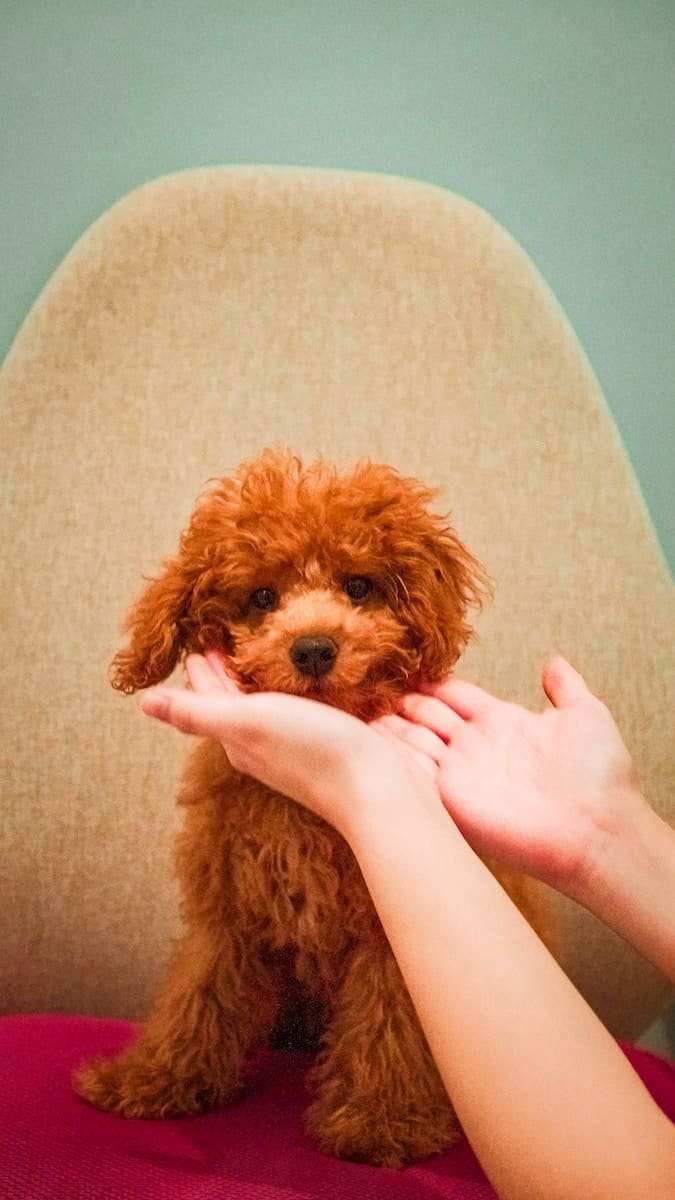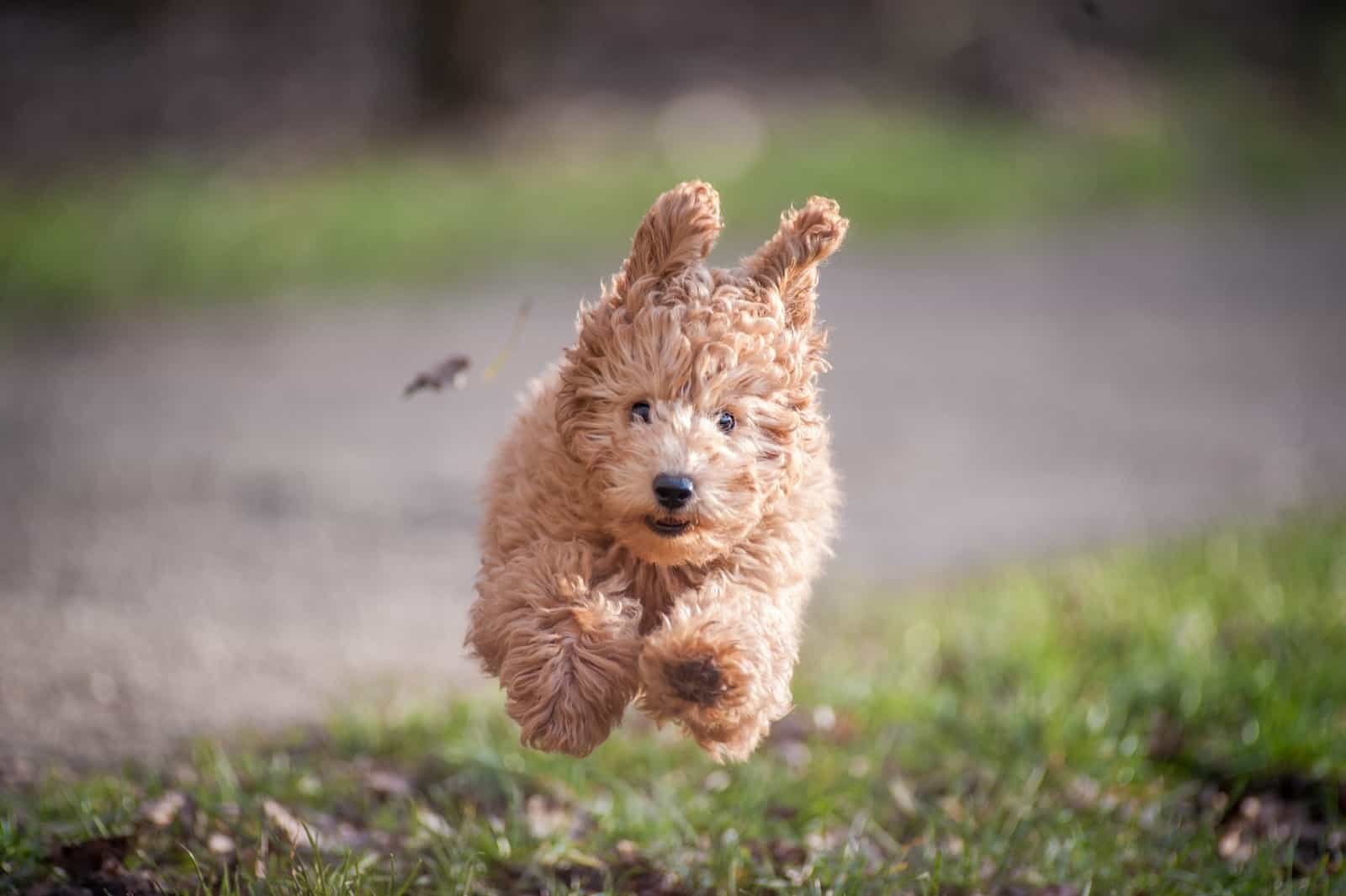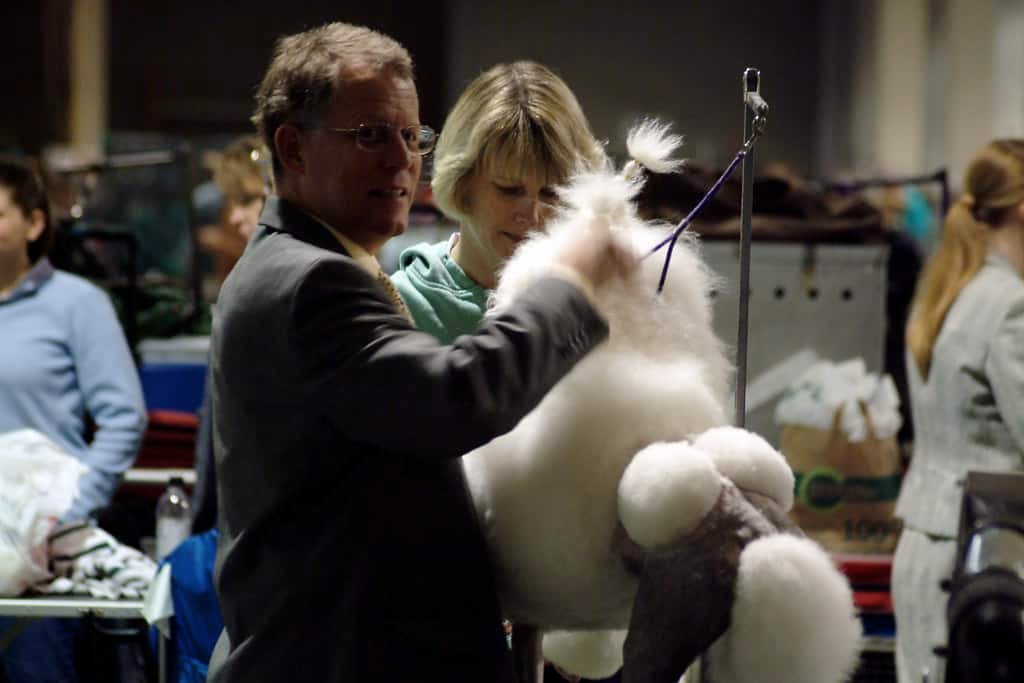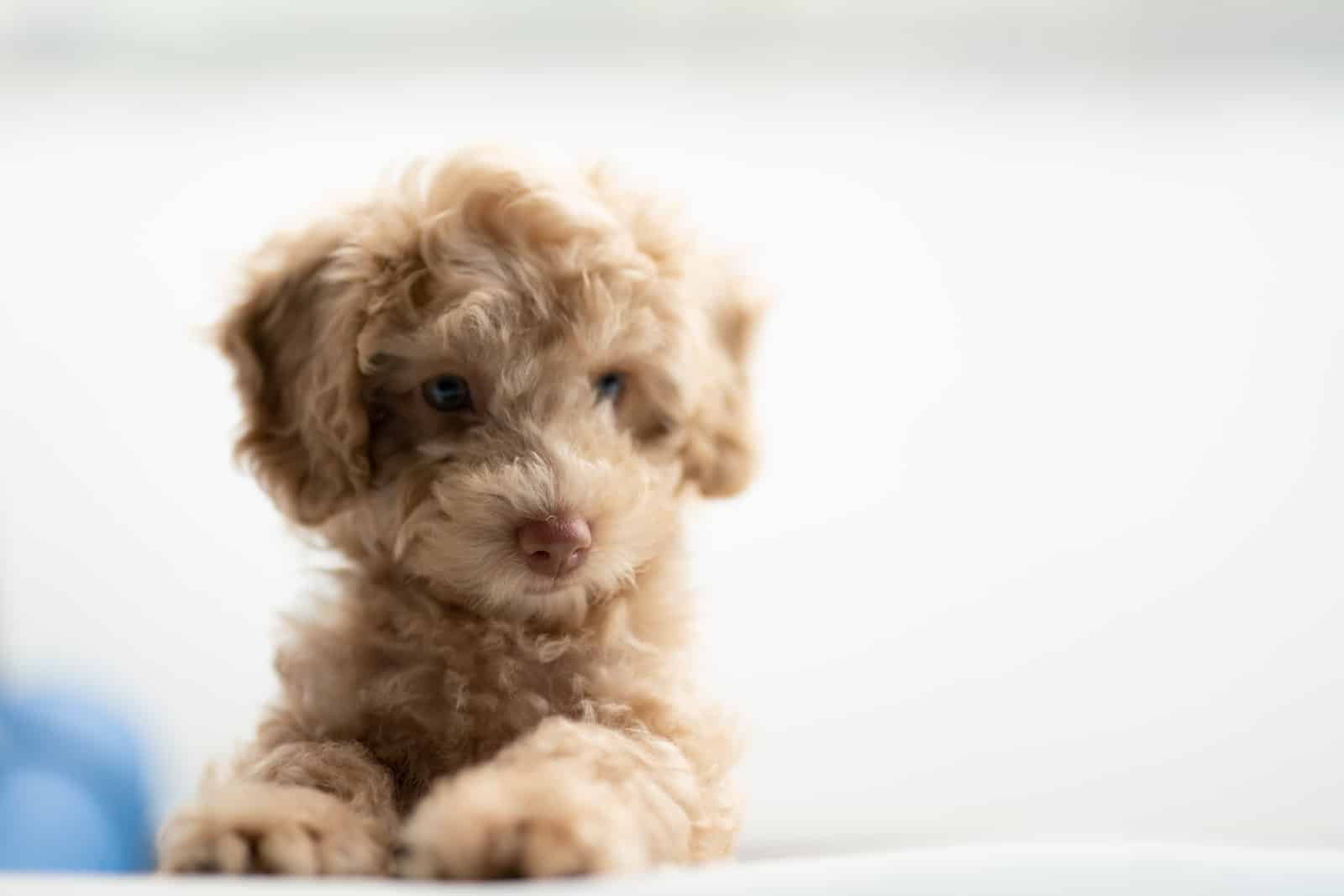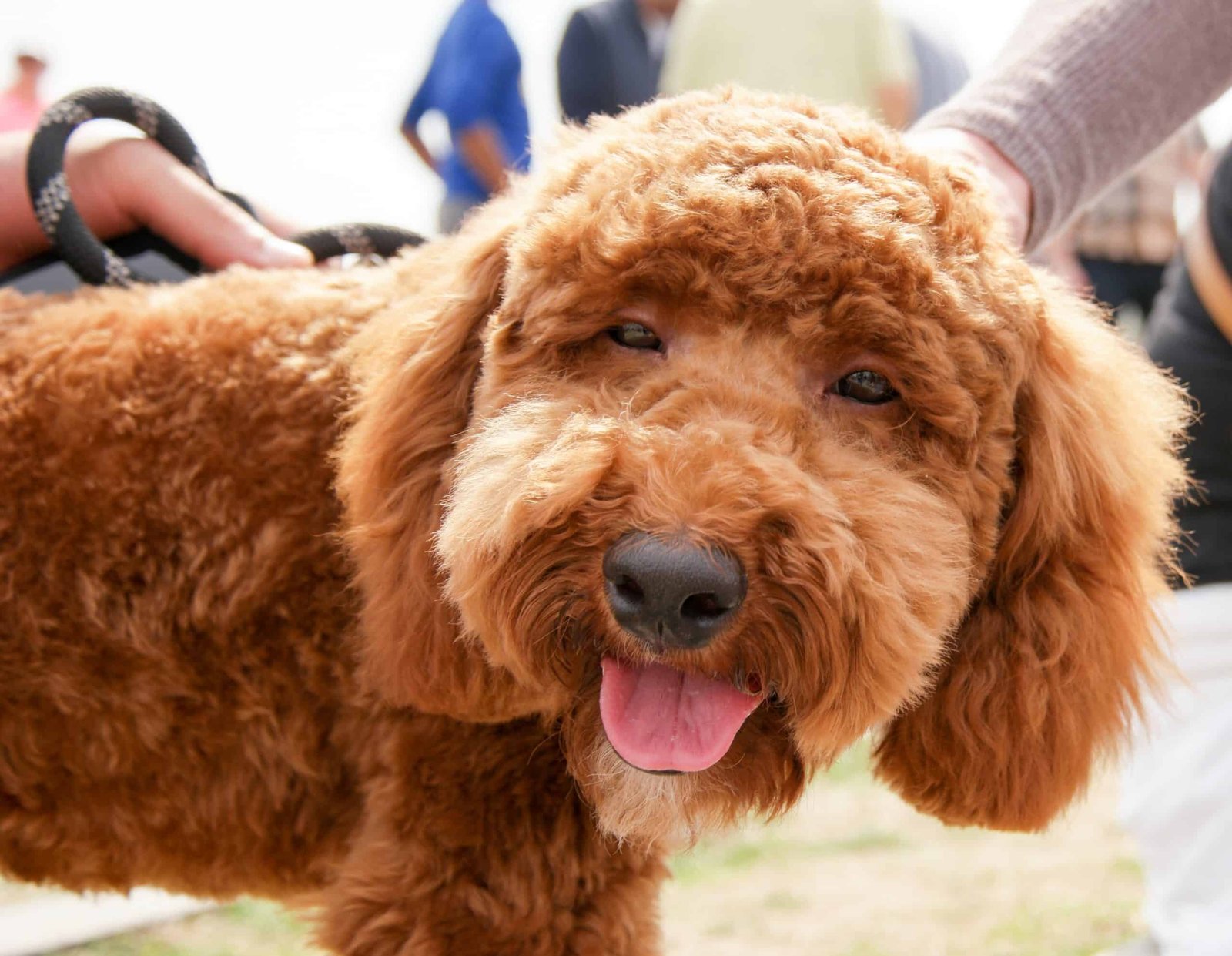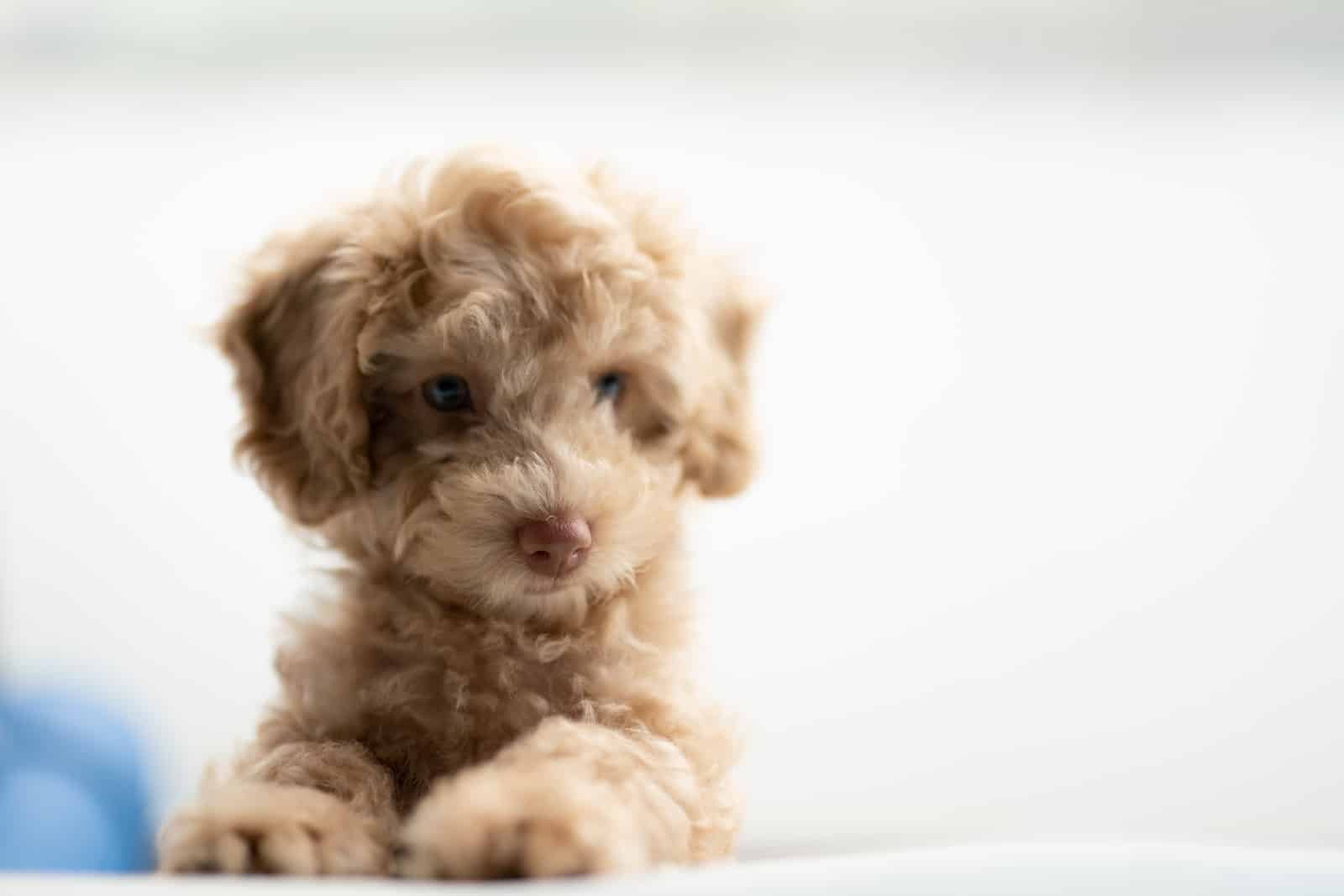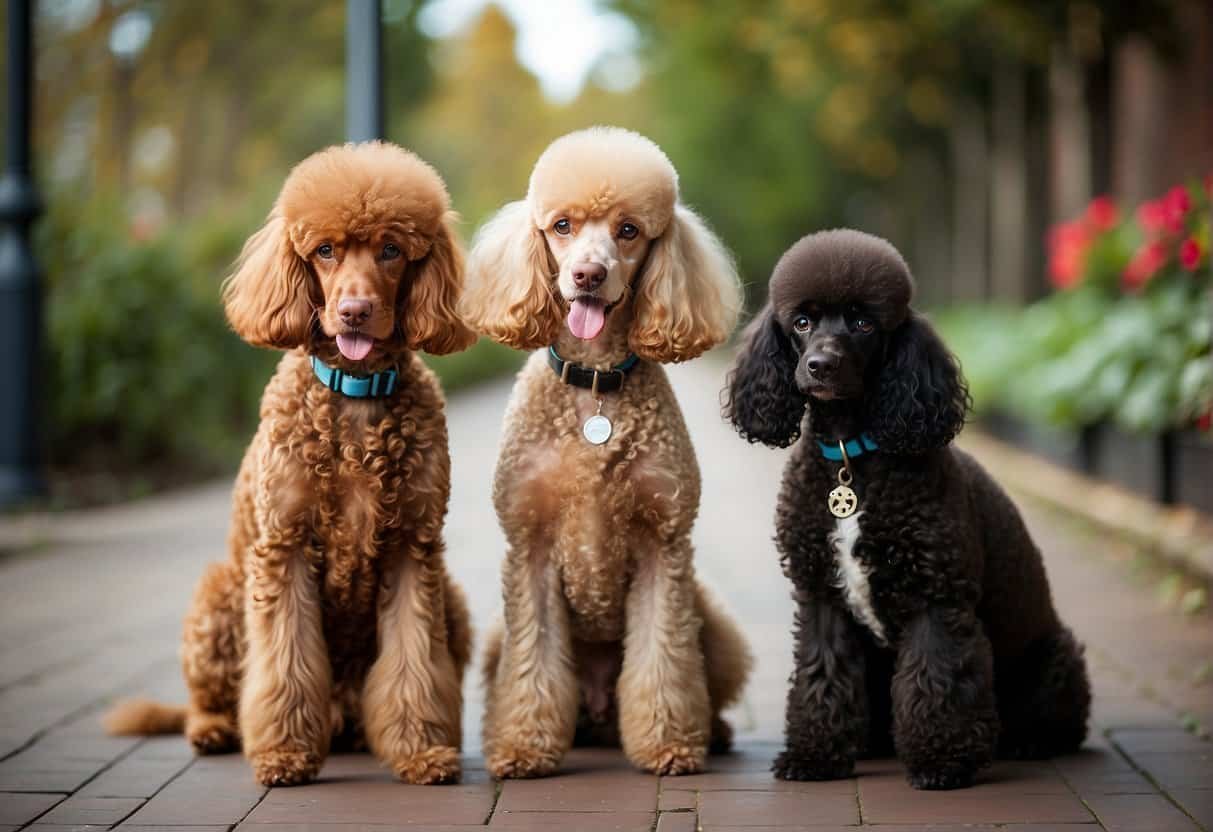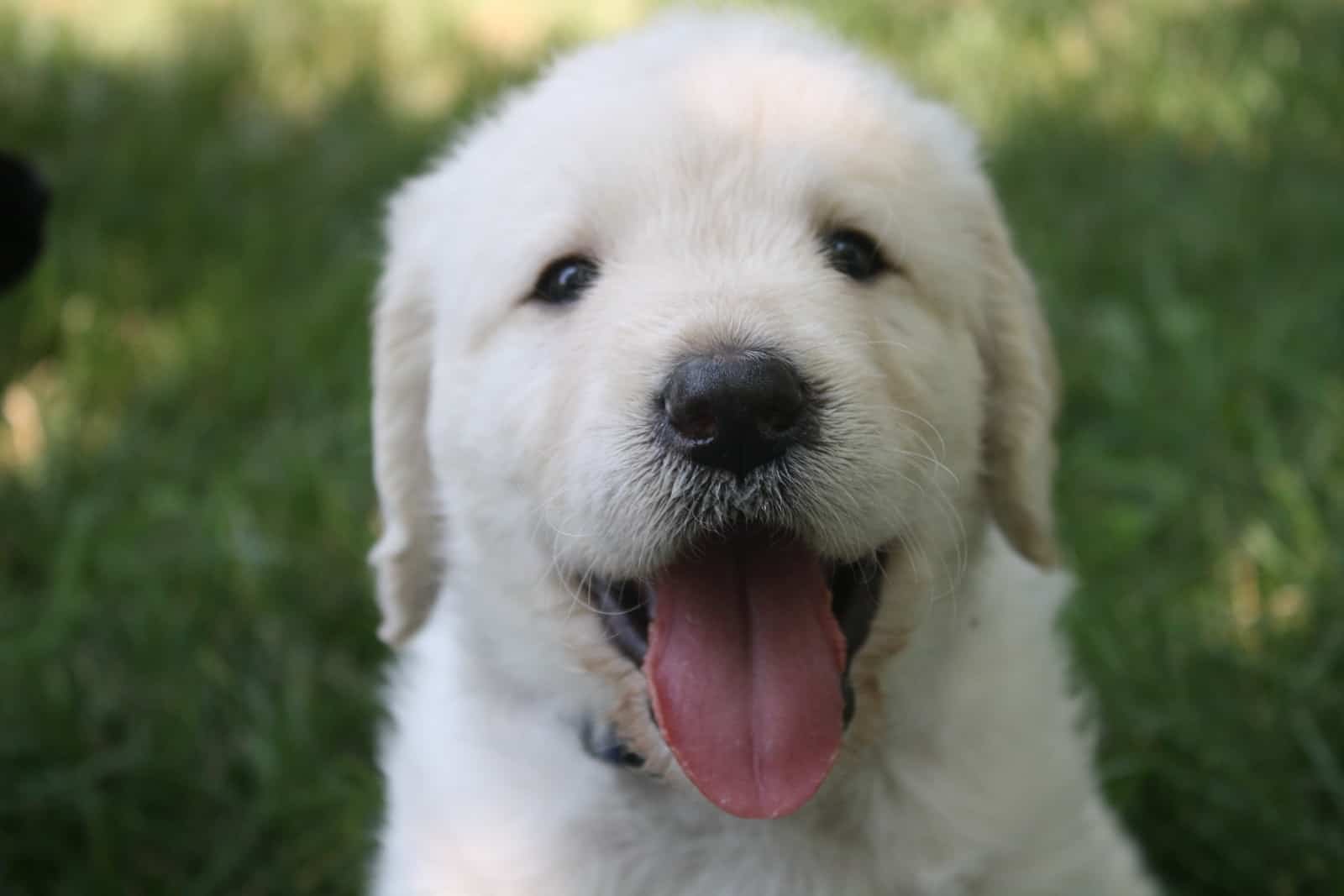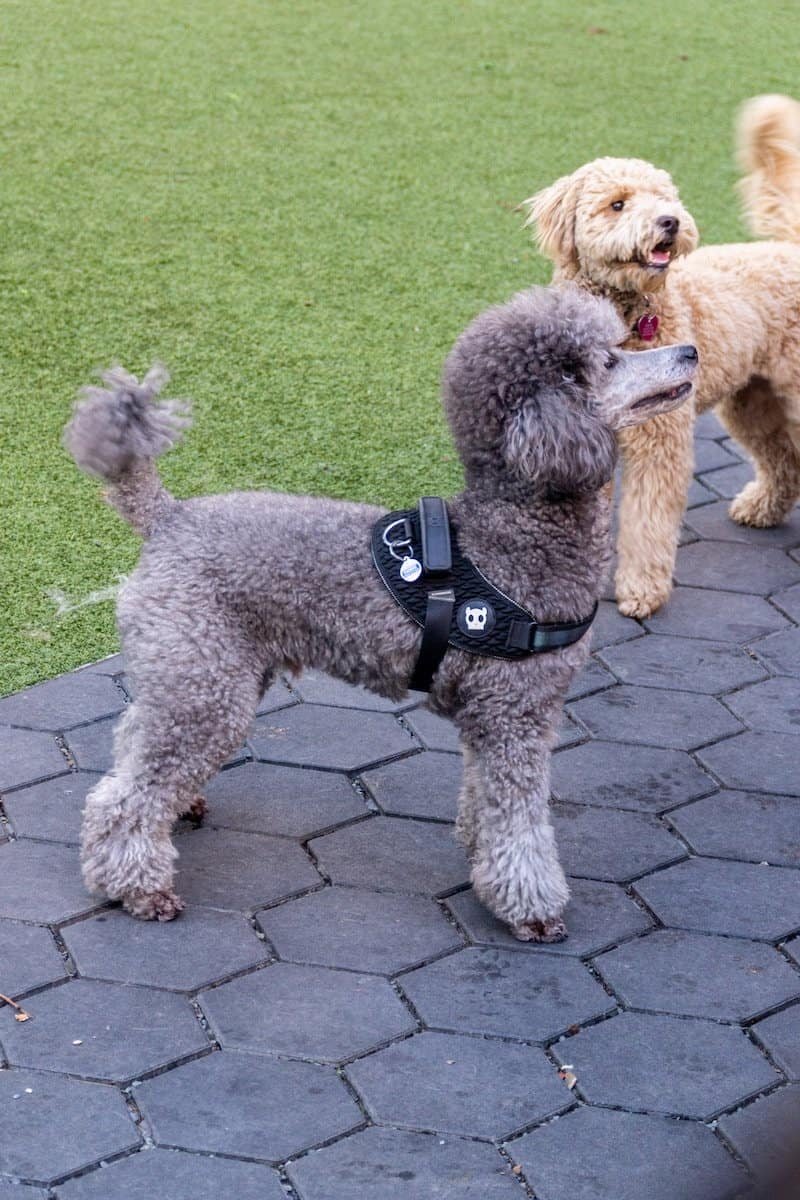
If you’re considering getting a poodle, you may be wondering about the differences between the toy, miniature, and standard varieties. While all three types of poodles share certain characteristics, they also have distinct differences that can affect their suitability as pets.
Poodles are a highly intelligent and trainable breed that are known for their curly, hypoallergenic coats. They come in three sizes: toy, miniature, and standard. Toy poodles are the smallest of the three, standing less than 10 inches tall at the shoulder and weighing less than 10 pounds. Miniature poodles are slightly larger, standing between 11 and 15 inches tall at the shoulder and weighing between 10 and 15 pounds. Standard poodles are the largest of the three, standing over 15 inches tall at the shoulder and weighing between 40 and 70 pounds. While all three types of poodles share these basic characteristics, there are some key differences that set them apart.
Key Takeaways
- Poodles come in three main sizes: toy (small), miniature (medium), and standard (large).
- Toy poodles are the smallest of the three, while standard poodles are the largest.
- While all three types of poodles share certain characteristics, they also have distinct differences that can affect their suitability as pets.
Overview of Poodles
Poodles are a popular dog breed known for their curly, hypoallergenic coat and elegant appearance. They are a highly intelligent and trainable breed, making them a favorite of many dog owners. Toy, miniature, and standard poodles each have their own unique characteristics, but all share the same breed.
The Poodle originated in Germany as a water retriever. They were later popularized in France and became the national dog of France. Today, Poodles are recognized by the American Kennel Club and the British Kennel Club and are a popular show dog breed.
The Toy Poodle is the smallest of the three sizes, standing at 10 inches or less at the shoulder and weighing between 4 and 6 pounds. They are the perfect lap dog and are well-suited for apartment living. Toy Poodles are known for their intelligence, loyalty, and affectionate nature.
The Miniature Poodle is slightly larger, standing between 11 and 15 inches at the shoulder and weighing between 10 and 15 pounds. They are a great choice for families with children and are known for their playful and energetic nature. Miniature Poodles are also highly trainable and excel in obedience competitions.
The Standard Poodle is the largest of the three sizes, standing over 15 inches at the shoulder and weighing between 40 and 70 pounds. They are a versatile breed and excel in a variety of roles, including hunting, retrieving, and as a service dog.
In terms of appearance, all poodles have a curly, dense coat that comes in a variety of solid colors. They require regular grooming to maintain their coat and prevent matting. Poodles are also known for their long lifespan, with an average lifespan of 12-15 years.
Overall, Poodles are a beloved breed known for their intelligence, loyalty, and elegant appearance. Whether you prefer a small lap dog or a larger, more versatile breed, there is a Poodle size that is right for you.
Distinct Characteristics of Poodles
Each size poodle have their own distinct characteristics that make them unique and desirable to different types of owners.
Toy Poodles are the smallest variety of poodles. They typically weigh between 4-6 pounds and stand 10 inches tall or less, making them the most suitable breed for apartment living. Toy Poodles are typically high-energy and require regular exercise, mental stimulation, and human interaction to stay healthy and happy. This breed is known for its intelligence and enthusiasm, making them great companions for the elderly or those who live alone.
Miniature Poodles are slightly larger than Toy Poodles, usually standing between 11-15 inches tall and weighing between 10-15 pounds. They have a playful, energetic personality that makes them great companions for families with children. Miniature Poodles are also highly trainable and excel in obedience competitions.
Standard Poodles are the largest variety of poodles, standing over 15 inches tall and weighing between 40-70 pounds. They have a strong work ethic, making them great hunting or retrieving dogs. Standard Poodles are known for their athleticism and intelligence, making them excellent service dogs in a variety of roles.
Appearance
One of the most noticeable differences between the three sizes of poodles is their appearance. Standard poodles are the largest of the three, reaching up to 24 inches tall and weighing anywhere from 40-70 pounds. Miniature poodles are slightly smaller, standing between 11-15 inches tall, while toy poodles are the smallest, reaching a maximum height of 10 inches. Despite their size differences, all three types of poodles have a similar appearance with their curly, dense hair and solid colors.
Intelligence
Poodles are known for their intelligence and trainability. They are quick learners and excel in obedience training, making them a popular choice for competitions and shows. Their intelligence also makes them highly adaptable to different environments and lifestyles, allowing them to thrive in a variety of households.
Activity Level
Poodles are an active breed that require daily exercise to stay healthy and happy. Toy poodles benefit from approximately 20 minutes of walking daily, while miniature poodles thrive on around 30 minutes. Standard poodles are the most active of the three and require at least an hour of exercise per day. They also enjoy participating in water sports, such as swimming.
Temperament
Poodles are friendly, fun, and energetic dogs that make great playful for families and individuals. They are known for their playful personalities and love to be around people. Poodles are also highly adaptable to different living situations, making them a great choice for apartment dwellers or those with smaller homes.
In conclusion, while all three sizes of poodles share similar characteristics such as their intelligence and friendly temperament, their size and activity level can differ greatly. It’s important to consider your lifestyle and living situation when choosing which size of poodle is right for you.
The Toy Poodle
If you are looking for a small dog that is perfect for apartment living, then the Toy Poodle might be the right choice for you. The Toy Poodle is the smallest of the three poodle sizes, weighing less than 10 pounds and standing no taller than 10 inches at the shoulder. They are a popular choice for pet owners who want a small and portable dog that is also family-friendly.
Toy Poodles are known for their intelligence, loyalty, and playful nature. They are an affectionate breed that loves to be around people and are great with children. They are also other pet-friendly, which makes them a great choice for families with other pets.
One of the benefits of owning a Toy Poodle is that they require minimal exercise. They are content with a short walk or playtime indoors, making them a great choice for pet owners who have limited outdoor space. However, they still need daily exercise to maintain their health and prevent obesity.
Toy Poodles are also known for their hypoallergenic coat, which makes them a great choice for pet owners with allergies. Their curly, dense coat does not shed much, which means less hair to clean up around the house.
In summary, the Toy Poodle is a great choice for pet owners who want a small, intelligent, and affectionate dog that requires minimal exercise and is hypoallergenic. They are perfect for apartment living and are great with children and other pets.
The Miniature Poodle
The Miniature Poodle is a smaller version of the Standard Poodle. It is a popular breed due to its size, intelligence, and playful personality. Miniature Poodles are typically between 11 and 15 inches and weigh about 13 pounds when fully grown. They are a good choice for people who want a smaller dog but still want the intelligence and trainability of a Poodle.
Size and Weight
The Miniature Poodle is typically a little larger than the Toy Poodle and stands approximately 13 inches and weighs around 13 pounds when fully grown. They are a small to medium-sized dog that is perfect for apartment living. They are also a good choice for families with children.
Coat
The Miniature Poodle has a thick, curly coat that requires regular grooming. They do not shed much, making them a good choice for people with allergies. Regular grooming is needed to help maintain healthy looking coat while also preventing matting.
Temperament
Miniature Poodles are known for their intelligence, trainability, and playful personality. They are loyal and affectionate dogs that make great companions while also beinggood with children and other pets. They are energetic dogs that require regular exercise and mental stimulation.
Training
Miniature Poodles are highly intelligent and trainable dogs. They are eager to please their owners and respond well to positive reinforcement training. They excel in obedience training and can learn a variety of tricks and commands. It is important to provide them with regular mental stimulation to prevent boredom and destructive behavior.
Health
Miniature Poodles are generally healthy dogs, but like all breeds, they are prone to certain health issues. Some of the health issues that Miniature Poodles may be prone to include:
- Hip dysplasia
- Patellar luxation
- Progressive retinal atrophy
- Epilepsy
- Addison’s disease
Regular veterinary checkups and proper care can help prevent or manage these health issues.
In summary, the Miniature Poodle is a small to medium-sized dog that is known for its intelligence, trainability, and playful personality. They are a good choice for people who want a smaller dog but still want the intelligence and trainability of a Poodle. They require regular grooming and exercise, but they make great companions for families with children and other pets.
The Standard Poodle
When most people think of poodles, they are likely thinking of the Standard Poodle. This is the largest of the three poodle breeds and is known for its elegant appearance and high intelligence.
Standard Poodles are typically between 22 and 27 inches tall at the shoulder and weigh between 45 and 70 pounds. They have a long, narrow head with a well-defined stop and a long, straight muzzle. Their eyes are oval-shaped and dark, and their ears hang close to their head.
A Standard Poodle’s coat is quite distinctive. They have a dense, curly coat that is typically either solid black, white, or brown. However, they can also come in other colors, such as gray, apricot, and red. Their coat requires regular grooming to prevent matting and tangling.
Despite their elegant appearance, Standard Poodles are highly athletic and were originally bred as water retrievers. They are excellent swimmers and have a strong prey drive, which means they may be prone to chasing small animals.
In terms of temperament, Standard Poodles are known for being highly intelligent and trainable. They are also affectionate and loyal to their families. However, they can be reserved around strangers and may require early socialization to prevent shyness or fearfulness.
Overall, the Standard Poodle is a highly versatile breed that can excel in a variety of activities, including obedience, agility, and hunting. They are a great choice for active families who are willing to provide them with plenty of exercise and mental stimulation.
Visual Differences Among Poodle Types
When it comes to poodles, there are three main types: toy, miniature, and standard. While all three types share many similarities, there are also some key differences, particularly in terms of their size and appearance.
The most obvious visual difference between the three types of poodles is their size. Toy poodles are the smallest of the three, typically standing no more than 10 inches tall at the shoulder and weighing between 4 and 6 pounds. Miniature poodles are slightly larger, standing between 11 and 15 inches tall and weighing between 10 and 15 pounds. Standard poodles are the largest of the three, standing at least 15 inches tall and weighing between 45 and 70 pounds.
Another key difference between the three types of poodles is their coat. While all poodles have dense, curly coats, there are some variations in terms of texture and color. Toy and miniature poodles can come in a wider variety of colors, including white, black, brown, gray, and apricot. Standard poodles, on the other hand, are typically only found in solid colors such as black, white, brown, and gray.
In terms of coat texture, toy and miniature poodles often have a softer, finer coat than standard poodles. This can make their fur appear fluffier and more delicate. Standard poodles, on the other hand, have a coarser, more wiry coat that can be styled in a variety of ways.
Overall, while there are some differences in terms of size and coat texture, all three types of poodles share many similarities. They are intelligent, loyal, and affectionate dogs that make great pets for families and individuals alike.
Personality and Temperament
Poodles are known for their unique personalities and temperaments that make them stand out from other dog breeds. They are intelligent, active, friendly, and loyal, which makes them great pets for families and individuals alike. Understanding the personality traits and temperaments of each type of poodle can help you choose the right one for you.
Standard Poodles
They are highly sociable and friendly, making them great family pets. They are also active and require regular exercise to keep them healthy and happy. Standard Poodles are easy to train due to their high intelligence and eagerness to please their owners. They are also known to be protective of their families, making them great watchdogs.
Miniature Poodles
Miniature Poodles share many of the same personality traits as Standard Poodles. They are intelligent, friendly, and loyal, but they are also known to be more energetic and playful. They are highly sociable and enjoy being around people and other pets. Miniature Poodles are also easy to train and are great for families with children.
Toy Poodles
Toy Poodles are the smallest of the poodle breeds and have a unique personality that sets them apart from other poodles. They are highly intelligent, sociable, and friendly, but they are also known to be more sensitive than other poodles. Toy Poodles require a lot of attention and affection from their owners, and they can become anxious or bored if left alone for long periods. They are also easy to train and make great pets for families with children.
Overall, poodles are highly sociable and friendly, making them great family pets. Understanding the personality traits and temperaments of each type of poodle can help you choose the right one for you.
Health and Lifespan
Poodles are generally healthy dogs with a lifespan of 12 to 15 years. However, like all breeds, they are prone to certain health issues that owners should be aware of.
One of the most common health issues in poodles is patellar luxation, which is a condition where the kneecap dislocates from its normal position. This can cause lameness and discomfort, and in severe cases, surgery may be required. Poodles are also prone to hip dysplasia, which is a genetic condition that affects the hip joint and can lead to arthritis and mobility issues.
Another health issue that poodles may face is Progressive Retinal Atrophy (PRA), which is a degenerative eye disease that can lead to blindness. PRA is a genetic condition, so it is important to choose a reputable breeder who tests their dogs for this condition.
Poodles may also suffer from sebaceous adenitis, which is a skin condition that can cause hair loss and skin inflammation. Other health issues that poodles may be prone to include allergies, Addison’s disease, diabetes, hypothyroidism, atrial septal defect, Legg-Calve-Perthes disease, muscular dystrophy, and cardiovascular disease.
To ensure your poodle stays healthy, it is important to provide them with a balanced diet, regular exercise, and routine veterinary check-ups. Regular grooming is also important to prevent skin and coat issues.
In summary, poodles are generally healthy dogs with a long lifespan, but like all breeds, they are prone to certain health issues. By being aware of these issues and providing your poodle with proper care, you can help ensure they live a long and healthy life.
Grooming and Care
Taking care of a poodle’s coat is essential to keep it healthy and looking its best. The grooming needs of each poodle size are different, but they all require regular grooming to maintain their coats. In this section, we will discuss the grooming requirements of toy, miniature, and standard poodles.
Toy Poodles
Toy Poodles have a dense, curly coat that requires regular grooming to prevent matting and tangling. They need to be brushed daily to remove any loose hair and to keep their coat clean and healthy. It is important to use a slicker brush to get through their thick coat. Toy Poodles also need to be trimmed regularly to maintain their coat’s shape and to prevent it from getting too long.
Miniature Poodles
Miniature Poodles have a thick, curly coat that requires regular grooming to prevent matting and tangling. They need to be brushed daily to remove any loose hair and to keep their coat clean and healthy. It is important to use a slicker brush to get through their thick coat. Miniature Poodles also need to be trimmed regularly to maintain their coat’s shape and to prevent it from getting too long.
Standard Poodles
Standard Poodles have a thick, curly coat that requires regular grooming to prevent matting and tangling. They need to be brushed daily to remove any loose hair and to keep their coat clean and healthy. It is important to use a slicker brush to get through their thick coat. Standard Poodles also need to be trimmed regularly to maintain their coat’s shape and to prevent it from getting too long.
All poodles require regular baths, and it is essential to use a high-quality shampoo and conditioner to keep their coat healthy and shiny. It is also important to clean their ears regularly to prevent infections. Poodles are prone to dental problems, so it is vital to brush their teeth regularly.
In conclusion, grooming and care are essential for all poodle sizes. Regular grooming and trimming are necessary to keep their coat healthy and prevent matting and tangling. Daily brushing, regular baths, and dental care are also essential to keep your poodle healthy and looking its best.
Exercise and Mental Stimulation
To keep your poodle healthy and happy, you need to provide them with regular exercise and mental stimulation. Poodles are known for their high energy levels, so it is important to give them plenty of opportunities to burn off that energy. In this section, we will discuss the exercise and mental stimulation needs of toy, miniature, and standard poodles.
Exercise
All poodles, regardless of their size, need daily exercise to stay healthy. However, the amount of exercise they require can vary depending on their size. Toy poodles are the smallest of the three sizes, and they require the least amount of exercise. A daily walk and some purposeful activity and play should be enough to keep them healthy and happy. Miniature poodles require more exercise than toy poodles, and not as much as standard poodles. A daily walk of around 60 minutes and some playtime should be enough to meet their exercise needs. Standard poodles are the largest of the three sizes and require the most exercise. They are highly energetic and need at least 60 minutes of exercise every day. This can be achieved through activities such as a brisk walk, swimming, or playing fetch.
Mental Stimulation
In addition to physical exercise, poodles also need mental stimulation to keep their minds sharp and prevent boredom. This is especially important for toy and miniature poodles, who are known for their intelligence. Providing them with mental stimulation can help prevent destructive behaviors such as chewing and digging. Some ways to provide mental stimulation include playing games, training, and giving them puzzle toys to solve. Standard poodles also require mental stimulation, but they tend to be less prone to destructive behaviors than toy and miniature poodles.
In conclusion, providing your poodle with regular exercise and mental stimulation is essential for their health and happiness. The amount of exercise they require varies depending on their size, but all poodles need daily exercise. Mental stimulation is also important, especially for toy and miniature poodles. By meeting their exercise and mental stimulation needs, you can ensure that your poodle lives a happy and healthy life.
Training and Obedience
Training and obedience are crucial for all types of Poodles, regardless of their size. Poodles are highly intelligent dogs that are eager to please their owners. They respond well to positive reinforcement training techniques, which involve rewarding good behavior rather than punishing bad behavior.
When training your Poodle, it is important to start early and be consistent. Puppies should begin obedience training as soon as they are old enough to understand basic commands. This will help them develop good habits and prevent bad habits from forming.
One of the most important aspects of training your Poodle is socialization. Poodles are social dogs that thrive on interaction with people and other animals. Socialization should begin early and continue throughout your Poodle’s life. This will help your Poodle become a well-adjusted and well-behaved member of your family.
Positive reinforcement training techniques involve rewarding your Poodle for good behavior with treats, praise, and affection. This type of training is effective because it reinforces good behavior and encourages your Poodle to repeat it. Punishing bad behavior is not recommended, as it can cause fear and anxiety in your Poodle.
Obedience training is also important for your Poodle’s safety. A well-trained Poodle will respond to commands such as “come,” “stay,” and “heel,” which can prevent accidents and keep your Poodle out of harm’s way.
In summary, training and obedience are essential for all types of Poodles. Positive reinforcement techniques, socialization, and consistency are key to successful training. With proper training, your Poodle will become a well-behaved and well-adjusted member of your family.
Poodles and Family
Poodles are known for their intelligence, loyalty, and affectionate nature, making them a popular choice for families. Whether you have children or other pets, poodles are generally a good fit for families seeking a companion that is both family-friendly and other pet-friendly.
Toy poodles, miniature poodles, and standard poodles all make great family pets, but there are some differences between them that you should consider before making a decision.
Toy Poodles and Family
Toy poodles are the smallest of the three types of poodles, making them an excellent choice for families with limited space. They are also known for their playful and affectionate nature, which makes them great companions for children. However, due to their small size, they may not be the best choice for families with very young children who may accidentally hurt them.
Miniature Poodles and Family
Miniature poodles are a little larger than toy poodles, but still make great family pets. They are known for their intelligence and are easy to train, making them a great choice for families with children. They are also very loyal and affectionate, making them great companions for families seeking a pet that will be both a friend and protector.
Standard Poodles and Family
Standard poodles are the largest of the three types of poodles, making them a great choice for families with lots of space. They are known for their athleticism and are often used as service dogs. They are also very intelligent and easy to train, making them a great choice for families with children. However, due to their size, they may not be the best choice for families with very young children who may accidentally hurt them.
Overall, poodles are great family pets that are both family-friendly and other pet-friendly. Whether you choose a toy poodle, miniature poodle, or standard poodle, you can be sure that you are getting a loyal and affectionate companion that will be a great addition to your family.
Poodles and Other Pets
Poodles are social and friendly dogs, making them great companions for families with other pets. They can get along with other dogs, cats, and even small animals like rabbits and guinea pigs. However, it’s important to remember that every dog has its own personality and temperament, so it’s important to introduce your poodle to other animals slowly and carefully.
When introducing your poodle to other pets, it’s important to supervise their interactions. If your poodle is showing signs of aggression or discomfort, it’s best to separate them and try again later. Additionally, it’s important to make sure that all pets in the household are properly trained and socialized to prevent any potential conflicts.
Toy poodles are particularly well-suited to living with other pets, as they are small and gentle. They can make great playmates for cats, other small dogs, and are often well suited with seniors and/or children.
Miniature and standard poodles are also great with other pets, but their larger size can make them more intimidating to smaller animals. However, with proper training and socialization, they can get along with just about any pet.
Overall, poodles are great pets for families with other pets. They are social, friendly, and adaptable, making them a great addition to any household. Just remember to introduce them to other pets slowly and carefully, and always supervise their interactions to ensure everyone stays safe and happy.
Poodles and Lifestyle
When considering getting a poodle, it’s important to take into account your lifestyle and what you can provide for your furry friend. Poodles are energetic dogs that require daily exercise and mental stimulation to stay healthy and happy. The amount of exercise and stimulation needed will vary depending on the size of the poodle, with larger poodles generally requiring more exercise.
Toy poodles are the smallest of the poodle varieties and are well-suited for apartment living. They can get their daily exercise needs met with a short walk or indoor playtime. However, it’s important to provide them with mental stimulation, such as puzzle toys or training exercises, to keep their active minds engaged.
Miniature poodles are slightly larger and more active than toy poodles. They are great for families with children and can handle a bit more playtime and outdoor exercise. They enjoy walks and runs, as well as playing fetch in the backyard.
Standard poodles are the largest of the poodle varieties and require the most exercise and mental stimulation. They are athletic dogs that enjoy long walks, runs, and hikes. They also excel in activities such as agility and obedience training.
Regardless of the size, poodles are intelligent dogs that require mental stimulation to stay happy and healthy. Training exercises, interactive toys, and puzzle games are great ways to keep your poodle mentally stimulated. It’s important to note that poodles are social dogs and thrive on human interaction, so be sure to spend plenty of quality time with your furry friend.
In summary, when considering adding a poodle to your family, it’s important to take into account your lifestyle and what you can provide for your furry friend. All poodles require daily exercise and mental stimulation, with larger poodles requiring more exercise. Providing your poodle with proper exercise and mental stimulation will keep them healthy, happy, and well-behaved.
Poodles in Hunting and Retrieving
Poodles are often known for their fancy haircuts and show dog appearances, but they were originally bred as hunting dogs. Poodles have a keen sense of smell, excellent eyesight, and are strong swimmers, making them a natural fit for hunting and retrieving.
Poodles were originally bred in Germany as water retrievers. They were used to retrieve ducks and other waterfowl from the water. The Poodle’s curly coat helped to keep them warm in cold water, and their webbed feet made them excellent swimmers. They are also known for their agility and intelligence, which made them perfect for retrieving game from the water.
Today, Poodles are still used for hunting and retrieving, but it is not as common as it once was. Toy and Miniature Poodles are not typically used for hunting, but Standard Poodles are still used for duck hunting. Standard Poodles are larger and more muscular than Toy and Miniature Poodles, which makes them better suited for hunting and retrieving larger game.
If you are interested in hunting with your Poodle, it is important to train them properly. Hunting requires a lot of discipline and obedience, and it is important to start training your Poodle at a young age. You should also make sure that your Poodle is in good physical shape and has the stamina to handle the rigors of hunting.
In conclusion, Poodles have a rich history as hunting and retrieving dogs. While it is not as common today, Standard Poodles are still used for duck hunting. If you are interested in hunting with your Poodle, it is important to train them properly and make sure that they are in good physical shape.
Poodles and Allergies
If you or someone in your family has allergies, you may be interested in getting a hypoallergenic dog breed. While there is no such thing as a completely hypoallergenic dog breed, some breeds are less likely to cause allergic reactions than others. Poodles are one of those breeds that are often recommended for people with allergies.
Poodles have a unique coat that is made up of curly, dense hair that doesn’t shed much. This means that less allergens will be released into the air when a Poodle sheds, making them less likely to trigger allergic reactions in humans. In fact, all three size variations of Poodles, including the standard, miniature, and toy, are considered hypoallergenic.
However, it’s important to note that some people may still be allergic to Poodles, as allergies can vary from person to person. If you or someone in your family has severe allergies, it’s important to spend some time around Poodles before bringing one home to make sure that they don’t cause an allergic reaction.
If you already have a Poodle and suspect that they may be causing allergies, there are a few things that you can do to help alleviate the symptoms. Keeping your Poodle well-groomed and bathed can help reduce the amount of dander and hair that they shed, which can in turn reduce the amount of allergens in the air. You can also try using air filters or other allergy-reducing products in your home to help keep the air clean.
In summary, Poodles are often recommended for people with allergies due to their hypoallergenic coat. While they may not be completely allergen-free, they are less likely to cause allergic reactions than many other breeds. If you or someone in your family has severe allergies, it’s important to spend some time around Poodles before bringing one home to make sure that they don’t cause an allergic reaction. If you already have a Poodle and suspect that they may be causing allergies, there are several steps that you can take to help alleviate the symptoms.
Poodles and Anxiety
As with any breed of dog, poodles can experience anxiety. Separation anxiety is a common issue among poodles, especially toy and miniature poodles. This type of anxiety occurs when a dog becomes distressed when separated from their owner or when left alone for extended periods.
It is important to note that separation anxiety can manifest in different ways, including destructive behavior, excessive barking, and even self-harm. If you suspect your poodle is experiencing separation anxiety, it is important to address the issue as soon as possible.
Anxiety in general is another issue that can affect poodles. Poodles are known for their intelligence and sensitivity, which can make them more prone to anxiety. This can be triggered by a variety of factors, including changes in routine, loud noises, and unfamiliar situations.
If you notice your poodle displaying signs of anxiety, such as restlessness, excessive panting, or trembling, it is important to take steps to alleviate their stress. This can include providing a safe and comfortable space for them to retreat to, using calming aids such as pheromone sprays or supplements, and providing plenty of exercise and mental stimulation.
In addition to these measures, it is important to work with a veterinarian or animal behaviorist to develop a comprehensive plan for managing your poodle’s anxiety. This may include training exercises, medication, or other interventions as needed.
Overall, while anxiety can be a challenge for poodle owners, it is important to remember that with the right care and attention, most cases of anxiety can be effectively managed. By being attuned to your poodle’s needs and providing them with a safe and supportive environment, you can help them feel calm and secure.
Poodles in Agility and Sports
Poodles are an athletic breed that excel in many sports, including agility. Agility is a sport that involves a dog navigating an obstacle course as quickly as possible. Poodles, with their intelligence, athleticism, and eagerness to please, are a natural fit for this sport.
While all three sizes can participate in agility, the larger standard poodles tend to be more successful in the sport due to their size and strength. However, toy and miniature poodles can still excel in agility with proper training and conditioning.
Agility training for poodles typically involves teaching the dog to navigate various obstacles such as jumps, tunnels, weave poles, and seesaws. Poodles are intelligent and quick learners, making them ideal for this type of training.
In addition to agility, poodles can also participate in other sports such as dock diving, flyball, obedience, and rally. These sports provide mental and physical stimulation for poodles, which is essential for their overall well-being.
If you are interested in participating in sports with your poodle, it is important to start training early and to work with a qualified trainer. A good trainer can help you develop a training plan that is tailored to your dog’s abilities and can help you and your dog reach your full potential in the sport.
Overall, poodles are a versatile breed that can excel in a variety of sports, including agility. With their intelligence, athleticism, and eagerness to please, poodles make great companions for those who enjoy an active lifestyle.
Poodles in Breeding
When it comes to breeding Poodles, it is important to understand the different types of Poodles available. The American Kennel Club recognizes three types of Poodles: Standard, Miniature, and Toy. All three types have the same standards and are separated only by size.
Breeding Poodles is a popular practice, and it has led to the creation of several Poodle mixes, such as the Goldendoodle and Labradoodle. These mixes are often bred for their hypoallergenic qualities and friendly personalities. However, it is important to note that not all Poodle mixes are created equal, and it is important to do your research before bringing one into your home.
When breeding Poodles, it is important to consider the health of the dogs. Poodles are prone to certain health issues, such as hip dysplasia, eye problems, and skin allergies. It is important to choose healthy breeding stock and to have them tested for any potential health issues.
Another important factor to consider when breeding Poodles is temperament. Poodles are known for their intelligence, trainability, and friendly personalities. It is important to choose breeding stock with good temperaments to ensure that the puppies inherit these traits.
Overall, breeding Poodles can be a rewarding experience, but it is important to do your research and choose healthy breeding stock with good temperaments. By doing so, you can help ensure that your puppies are healthy, happy, and make great pets for years to come.
Poodles and Shedding
Poodles are known for their hypoallergenic coat, which makes them a popular choice for people with allergies. However, it is important to understand that all dogs shed to some extent, even Poodles. Shedding is a natural process that helps dogs get rid of old or damaged fur and replace it with new growth.
Toy, Miniature, and Standard Poodles all shed, but the amount of shedding can vary depending on the individual dog. Generally, smaller Poodles tend to shed less than larger ones. This is because they have less surface area on their body, which means there is less fur to shed.
It is important to note that Poodles do not shed in the same way that some other breeds do. Instead of losing large clumps of fur, Poodles shed small amounts of hair continuously throughout the year. This means that you may not notice shedding as much as you would with other breeds.
To minimize shedding, it is important to groom your Poodle regularly. Brushing your dog’s coat on a daily basis can help to remove loose hair and prevent it from spreading around your home. You may also want to consider having your Poodle professionally groomed every few months to keep their coat in top condition.
In addition to regular grooming, it is also important to provide your Poodle with a healthy diet and plenty of exercise. A well-nourished dog with a healthy coat is less likely to shed excessively, so make sure to feed your Poodle a high-quality dog food and provide them with plenty of opportunities to exercise and play.
Overall, shedding is a natural process that all dogs go through, including Poodles. However, with proper care and grooming, you can minimize shedding and keep your Poodle looking and feeling their best.
Origin and History of Poodles
Poodles are a breed of water dog that originated in Germany and France. The breed’s exact origins are a bit murky, but it is generally agreed upon that the poodle was developed as a hunting dog, specifically for retrieving waterfowl. The breed’s name comes from the German word “Pudel,” which means “to splash in water.”
The standard poodle was the original size, and the miniature and toy sizes were developed later. Each size was bred for different purposes, with the standard poodle being used for hunting larger game, the miniature poodle being used for hunting smaller game, and the toy poodle being bred for companionship.
Poodles were popular in France during the 18th century, and they became a symbol of French elegance and sophistication. They were often used as circus dogs and were trained to perform elaborate tricks and dances. Poodles were also bred for their distinctive curly coat, which was prized for its hypoallergenic qualities and was often styled in elaborate cuts.
Today, poodles are popular pets around the world and are known for their intelligence, loyalty, and affectionate nature. They are also commonly used as show dogs and are often trained for agility competitions. Despite their reputation as high-maintenance dogs, poodles are actually quite adaptable and can thrive in a variety of environments, from city apartments to rural farms.
Overall, the poodle’s history is a fascinating and complex one, with roots in both Germany and France. Whether you own a standard, miniature, or toy poodle, you can be sure that you are sharing your life with a breed that has a rich and storied past.
Frequently Asked Questions
Are you considering getting a Poodle, but you’re not quite sure which size is right for you? Here are some frequently asked questions to help you make an informed decision.
What are the sizes of Poodles?
Poodles come in three sizes: Toy, Miniature, and Standard. Toy Poodles are the smallest, measuring up to 10 inches at the shoulder and weighing between 4 to 6 pounds. Miniature Poodles are slightly larger, standing between 11 and 15 inches tall and weighing between 10 to 15 pounds. Standard Poodles are the largest, measuring over 15 inches at the shoulder and weighing between 45 to 70 pounds.
What are some Toy Poodle and a Miniature Poodle Differences?
Toy Poodles are smaller, measuring up to 10 inches at the shoulder, whereas Miniature Poodles are slightly larger, standing between 11 and 15 inches tall. However, both breeds share similar physical characteristics, such as their curly, hypoallergenic coat and their elegant appearance.
Explain the size difference between a Miniature Poodle and a Standard Poodle?
The size difference between a Miniature Poodle and a Standard Poodle is significant. Miniature Poodles stand between 11 and 15 inches tall at the shoulder, whereas Standard Poodles measure over 15 inches at the shoulder. Standard Poodles are also much heavier, weighing between 45 to 70 pounds, while Miniature Poodles weigh between 10 to 15 pounds.
What are the weight differences between a Miniature Poodle and a Standard Poodle?
The weight difference between a Miniature Poodle and a Standard Poodle is significant. Miniature Poodles weigh between 10 to 15 pounds, while Standard Poodles weigh between 45 to 70 pounds. This size difference can affect their health, as larger Poodles are more prone to certain health issues, such as hip dysplasia and bloat.
What are the common problems associated with Miniature Poodles?
Like all breeds, Miniature Poodles are prone to certain health issues. Some common problems associated with Miniature Poodles include dental issues, such as tooth decay and gum disease, eye problems, such as cataracts and progressive retinal atrophy, and joint problems, such as hip dysplasia and luxating patellas.
Should I get a Toy Poodle or a Miniature Poodle?
The decision to get a Toy Poodle or a Miniature Poodle ultimately depends on your lifestyle and preferences. If you live in a small apartment or have limited space, a Toy Poodle may be a better choice, as they require less space and exercise. But if you have a bigger home and like being outside with your dog, a Miniature Poodle might be a better choice. They are more energetic and need more exercise. The key is to pick a breed that matches your lifestyle and personality, so you can have a happy and healthy bond with your pet.
Poodles come in three sizes: Toy, Miniature, and Standard. Toy Poodles are the smallest, measuring up to 10 inches at the shoulder and weighing between 4 to 6 pounds. Miniature Poodles are slightly larger, standing between 11 and 15 inches tall and weighing between 10 to 15 pounds. Standard Poodles are the largest, measuring over 15 inches at the shoulder and weighing between 45 to 70 pounds.
What are the weight differences between a Miniature Poodle and a Standard Poodle?
The weight difference between a Miniature Poodle and a Standard Poodle is significant. Miniature Poodles weigh between 10 to 15 pounds, while Standard Poodles weigh between 45 to 70 pounds. This size difference can affect their health, as larger Poodles are more prone to certain health issues, such as hip dysplasia and bloat.
What are the common problems associated with Miniature Poodles?
Like all breeds, Miniature Poodles are prone to certain health issues. Some common problems associated with Miniature Poodles include dental issues, such as tooth decay and gum disease, eye problems, such as cataracts and progressive retinal atrophy, and joint problems, such as hip dysplasia and luxating patellas.
Should I get a Toy Poodle or a Miniature Poodle?
The decision to get a Toy Poodle or a Miniature Poodle ultimately depends on your lifestyle and preferences. If you live in a small apartment or have limited space, a Toy Poodle may be a better choice, as they require less space and exercise. However, if you have a larger home and enjoy spending time outdoors with your dog, a Miniature Poodle may be a better fit, as they are more active and require more exercise. Ultimately, the most important thing is to choose a breed that fits your lifestyle and personality, so you can enjoy a happy and healthy relationship with your furry friend.

